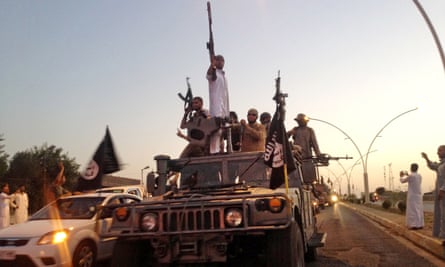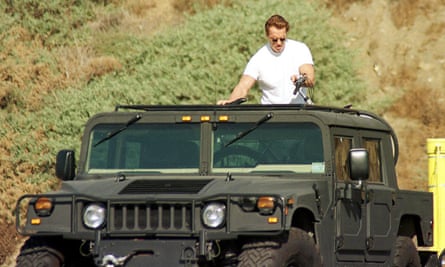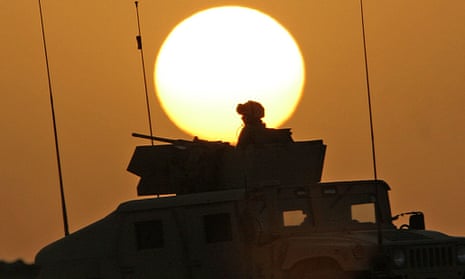It became the symbol of half a dozen US military interventions – a vehicle instantly recognisable across the globe, and as popular with the US military (if not with the actual soldiers) as with Islamic State, who stole 2,300 of them in Iraq during the fall of Mosul in 2014.
Now the US Department of Defense has announced the beginning of the end for the ubiquitous Humvee, awarding a $6.7bn contract to replace it to the Wisconsin firm Oshkosh.
As the Sherman tank was indelibly associated with the second world war, the Humvee bracketed a period of US interventionism that began with the invasion to topple Panamanian dictator Manuel Noriega in 1989 and will end in the chaos of Iraq and Afghanistan.
Oshkosh beat a team made up of Lockheed Martin Corp and Britain’s BAE Systems, as well as AM General, the privately owned company that built the original Humvees, for a deal that could be worth $30bn over time.
The US plans to buy a total of 55,000 of the Oshkosh’s Joint Light Tactical Vehicles, or JLTVs, to start replacing the current combined fleet of about 140,000 Humvees. The makers claim the new vehicles will be more nimble and better protected than their 30-year-old predecessors.

Replacing the equally iconic M151 jeep, the Humvee – from the acronym High Mobility Multipurpose Wheeled Vehicle – was first introduced by the US military in 1984 and first deployed in a combat role in Panama in 1989.
A year later it was being more widely used during the Gulf war.
Manufactured by AM General, the Humvee was instantly recognisable, low and wide, prompting the company – after the war – to produce a civilian model which, with its preposterously high fuel consumption and its bulk that made finding parking spaces difficult, epitomised a high point of macho motoring excess that attracted owners such as Arnold Schwarzenegger.
Its drawbacks as a military vehicle would, however, become quickly apparent in Somalia, not least during the Battle of Mogadishu, portrayed in the film Blackhawk Down.
While designed for moving infantry and light cargo reliably over long distances, the fighting in Mogadishu, which would characterise much of the urban combat US troops would encounter in the coming two decades, exposed its vulnerabilities.
The first Humvees – like the jeeps they replaced - had little protection, an issue that would be revisited after Somalia when the first armoured variants would appear.

In the early days in Afghanistan - after 9/11 - they seemed in their element again on rough roads in the days before the advent of increasingly sophisticated roadside bombs.
But it was with Iraq and Afghanistan that the vehicles would become most closely associated.
The reality – for all the excitement of the US military in the technology when it was first produced – was that they were ill-suited to the new forms of asymmetric warfare often in urban environments. Slow and, despite the high mobility moniker, lacking in agility, they were gas guzzlers who at best could manage about 12 miles to the gallon and closer to four in city traffic.
With a shortage of armoured versions, US soldiers in Iraq improvised their own protection, not least on the pick-up variant, sandwiching sandbags between ply or bolting on mild steel.
Despite the appearance of ever more armoured models with hardened glass, they were easy prey both for improvised explosive devices and buried tubes known as explosively formed penetrators.
By 2006, the high point of the US war in Iraq, some 67 US soldiers would die in their Humvees in bomb attacks in four months alone.

Boasting ever more armour, the vehicle became ever more ungainly, easy to roll and with doors soldiers found difficult to open.
In the US, Humvees were deployed on the streets of Ferguson, Missuouri, against protests in 2014 over the shooting of unarmed black teenager Michael Brown by a white police officer. A Pentagon programme had distributed surplus vehicles to police forces.
Scott Davis, the army’s executive officer for the programme, said the big winners of the replacement are the soldiers and Marines who will gain a vehicle that offers a better balance of protection, payload and performance.
“Our [new vehicle] has been extensively tested and is proven to provide the ballistic protection of a light tank,” John Urias, president of Oshkosh Defense and a retired army major general, said in a statement.
The appeal of the civilian Hummer has long been in decline. A vehicle that benefitted from a dubious military chic in the US, it started falling out of fashion in the late years of the last decade, hit both by high petrol prices and a population turning against the wars, which had initially made them popular.
Speaking to Newsweek in 2008, Michael Marsden, a professor of popular culture in Wisconsin, summed up the beginning of the decline. “It began in a heroic mode,” he said. “But then when 80% of the American public turns against the war, what do you have?”

Comments (…)
Sign in or create your Guardian account to join the discussion